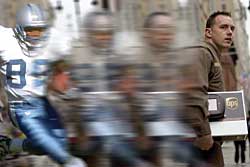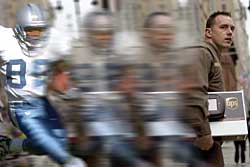
Training the Industrial Athlete: Fitness Training at UPS
Internal staff working with on-site health fitness professionals turned the tables on one district's work-related injuries.
 Ath-lete: A person who is trained or skilled in exercises, sports, or games requiring physical strength, agility, or stamina.
Ath-lete: A person who is trained or skilled in exercises, sports, or games requiring physical strength, agility, or stamina.
(Source: Merriam Webster Dictionary)
This article speaks to the training of Industrial Athletes, the men and women whose jobs require strength, agility, and stamina in a variety of industrial sectors. Keeping their bodies healthy and fit is the key to optimal performance and reduced injuries on the job.
Key findings in 2005 data complied by the Department of Labor indicate that sprains and strains were the leading nature of injury and illness in every major industry sector. More than four out of 10 injuries in 2005 were sprains and strains, most of which involved overexertion, falls on the same level, and bodily reaction.
These injuries are controllable and can be addressed most efficiently and cost-effectively through ergonomic-based health fitness protocols. In a 2001 statement introducing ergonomic standards in America, OSHA Assistant Secretary Charles N. Jeffress stated it clearly: "As OSHA's ergonomics standard takes effect today, more than 100 million workers across America can look forward to a brighter, more healthful future. That's because over the next 10 years, 4.6 million workers from poultry processors to data entry specialists to warehouse workers will be spared painful, potentially debilitating work-related musculoskeletal disorders (MSDs) . . . nearly 85 percent of U.S. employers who have not addressed ergonomics in their workplaces will begin to do so, and the results will benefit everyone. Workers will report problems earlier and get the help they need to prevent serious injury. Problem jobs will be fixed, preventing future workers from suffering MSDs. Employers will see medical expenses and workers' compensation costs go down and productivity go up. Total savings will amount to $9.1 billion each year."
Jeffress' statement is no less true today, despite the reversal of the ergonomics standard. Companies that seek innovative, cost-effective solutions to MSDs will need to incorporate ergonomic programs into their workplaces as standard operating procedure.
A Case in Point
The following case study is based on a two-year project with material handlers and drivers of light vehicles in the transportation industry. The process and application defined in the study can be replicated in any industry where job tasks and functions involve similar work tasks.
Education addressed deviated postures and poor body mechanics and how they lead to MSDs.
Background
In 2003, the UPS NorCal district was ranked 48th in a field of 50 in its organization structure in terms of associated worker's compensation injuries and costs. District administrators sought innovative, forward-thinking methods to address the problem. Health and safety administrators completed a three-year retrospective analysis of work-related injuries and quantified injuries by class, type, and prevalence. They decided to hire outside ergonomic specialists to tackle the job.
Getting Started
Consultants reviewed the retrospective analyses and the training materials used to educate drivers before they began the evaluation process. All ergonomic factors were assessed with particular attention to:
- Awkward and improper lift
- Deviated postures and poor body mechanics
- Excessive reaches
- Forceful exertions
- Environmental issue
Ergonomic risk factors were identified by type and prevalence and correlated to injuries by part of body. Anthropometric data also were collected, including age, height, weight, recreation activity, smoking, and years on the job
Reports included monthly aggregate reports to senior management and health and safety that enabled the internal team of professionals to fine-tune their messages to workers across the district, as well as quarterly reports and presentations to senior administrators that kept ergonomic health fitness promotion and injury prevention for employees at the forefront in operations.
A multi-disciplinary team, including professional exercise physiologists, kinesiologists, certified athletic trainers, and ergonomic health specialists, staffed the program. They provided one-to-one education, prevention, intervention, and post-rehabilitative expertise.
Work Factors
UPS athletes deliver a wide range of package sizes and weights, through all sorts of environmental conditions. The following basic numbers were obtained through the ergonomic evaluations on cars in NorCal.
Average miles walked annually: 1,25
Surfaces: cluttered, elevated and uneven, slippery, steep inclines
Average pounds lifted annually: 1,000,000
Average package weight: 20 pounds
Average volume: 350 packages daily
Average steps climbed with external weight: 225,000 per year on car steps only
Average miles driven and type, size, and condition of vehicles were dependent variables. Ergonomic evaluations were not conducted after dark; therefore, confounding environmental issues such as lighting, glare, and temperature variances were not assessed.
Methods of prevention included one-to-one education and hands-on training:
- On-car body mechanics and methods were corrected when necessary and documented for follow-up.
- Education addressed deviated postures and poor body mechanics and how they lead to MSDs.
Athletic Drill
A warm-up called the "Three-Minute Drill" was developed for the corporate group. The drill was aimed at improving joint range of motion specific to the industrial athletes' jobs. The gradual progressive warm-up flowed from neck and shoulder to forearm, wrist, torso, hamstring, gastrocnemius, soleus, ankle dorsi, and plantar flexion, incorporating balance, agility, and weight transference.
As a term most commonly used with athletic training, "drill" is designed to instill a pattern of movement that improves an athlete's performance and, over time, becomes second nature to the athlete. That process also works with the industrial athlete, who benefits by practicing particular patterns of movement aimed at increasing the range of motion and improving worker performance. It was introduced to every center in the district, as well as videotaped and distributed with pictures and instructions.
Athletic Training Clinics
Specialized athletic clinics were developed to address the most prevalent ergonomic and body mechanics issues discovered through the assessments. (If not corrected, these specific issues potentially lead to MSDs.) Athletic clinics specially designed to condition and improve the range of motion in the shoulder/neck, wrist/forearm, ankle/knee, and piriformis/back were included. Stretches and exercises were taught through demonstrations utilizing posture mirrors to aid the participant in proper technique. Individual and group protocols and training sessions covered:
- Body mechanics
- Stretch and flexibility
- Strength and conditioning
- Core training and conditioning
- Lift and lower techniques off cars
Hydration and Nutrition
Fueling the body while performing athletic proportion work is essential to reduce muscular fatigue that may lead to injury. This was a secondary focus. One NorCal facility created a "Hydration Station" and distributed drinking water to workers every morning; another packed healthy lunches and distributed those to drivers, and it also created an "H2O to Go" water distribution plan.
Employee Newsletter
To further reinforce the positive messages of working healthy, "SIDELINES, The UPSide of the News" was created for employees. This newsletter featured group success stories, tips on footwear, and exercise and stretching protocols specific to the potential ergonomic risks identified.
Engineering Controls
To reduce deviated and awkward postures, certain cars with equipped with lower grab bars and on-car steps. Seat and lumbar wedges were distributed to identified drivers.
Administrative Controls
From the outset, NorCal leadership implemented administrative controls, beefed up the safety program, created safety teams, and adopted a number of professional health fitness recommendations for their industrial athletes. Occupational health supervisors stepped up their roles and functions with treatment providers and networks to facilitate more effective after-care for injured workers.
Safety Controls
UPS's ongoing health and safety program and quality controls, while very comprehensive, got support from consultants who conducted new hire ergonomics and hands-on body mechanics education as part of the orientation process.
Athletic Training Space and Equipment
Space was limited but sufficient; conference room conversions and on-site trailers were utilized. The conditioning and measurement equipment used to train the industrial athletes included medicine balls, rollers, shoulder pulleys, thera-bands, belts, thera-canes, light hand and ankle weights, posture mirrors, barre, mats, scales, skinfold calipers, pedometers, blood pressure cuffs, and computerized exercise protocols.
Participation
Each center saw approximately four participants off work hours per hour for an average of 25-30 visits per day and a total of 500-550 visits per week. Third-party objectivity was important to the success of the voluntary participation and lessened concerns about sharing musculoskeletal issues or learning methods to improve the athletes' health and fitness. Senior administrators, center managers, and health and safety professionals working together as a team with the assistance of the on-site health fitness professionals were able to turn the tables on work-related injuries.
Results
By January 2006, the NorCal district had dramatically changed its position in the number of associated worker's compensation injuries and costs: Where it had been 48th, it was now ranked first in a field of 50!
- Injury rates were reduced by 50 percent in 2004.
- Injury rates were reduced by 85 percent in 2005.
- Worker's compensation costs were reduced by 60 percent in 2005.
This article appeared in the April 2007 issue of Occupational Health & Safety.
References
- Bureau of Labor Statistics, Dept. of Labor, Washington, D.C., Nov. 17, 2006.
- The 2005 Liberty Mutual Workplace Safety Index, September 2005.
- OSHA Public Affairs: Statement Of Assistant Secretary Charles N. Jeffress on Effective Date of OSHA Ergonomics Standard, Jan. 16, 2001.
This article originally appeared in the April 2007 issue of Occupational Health & Safety.